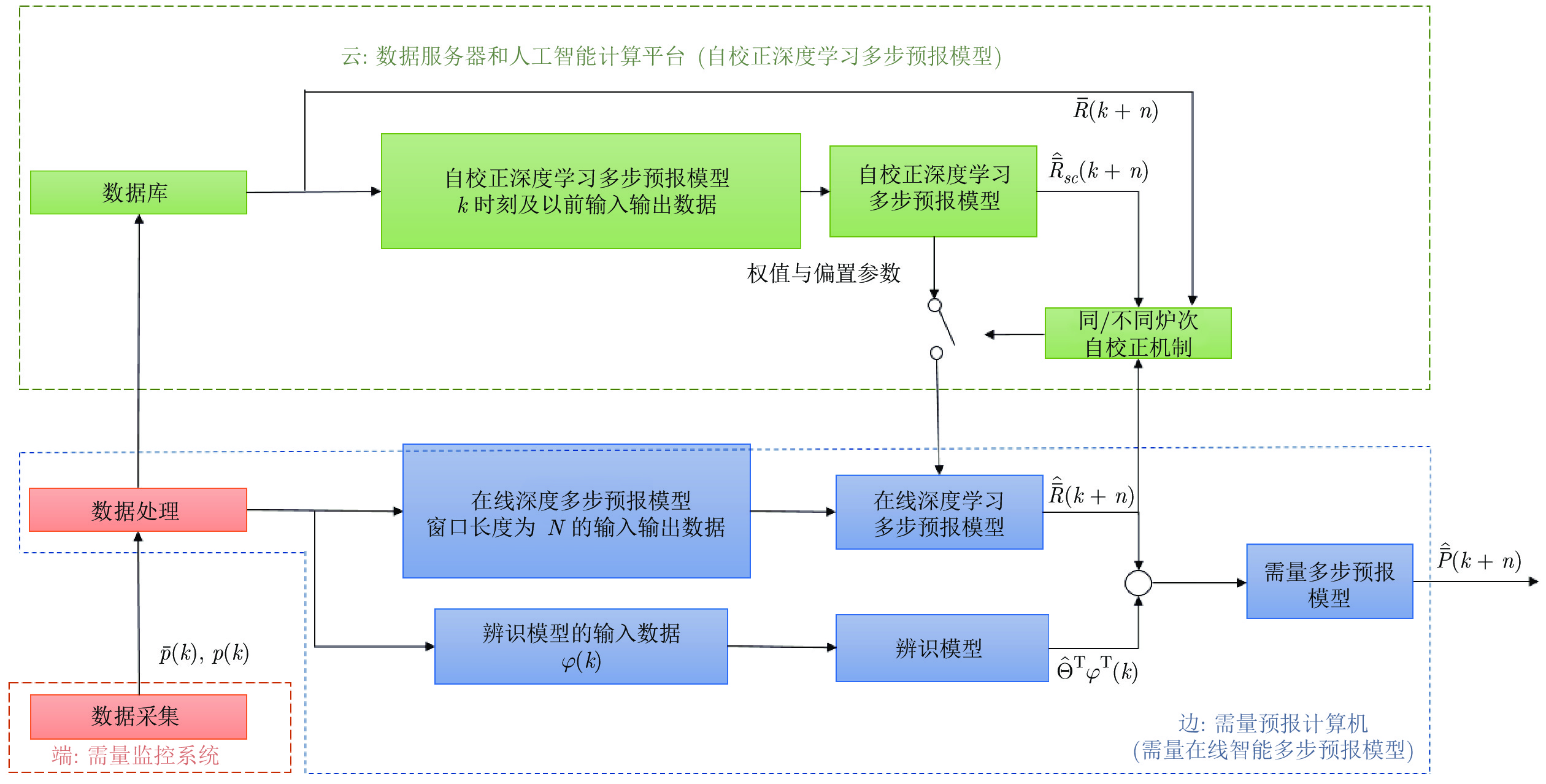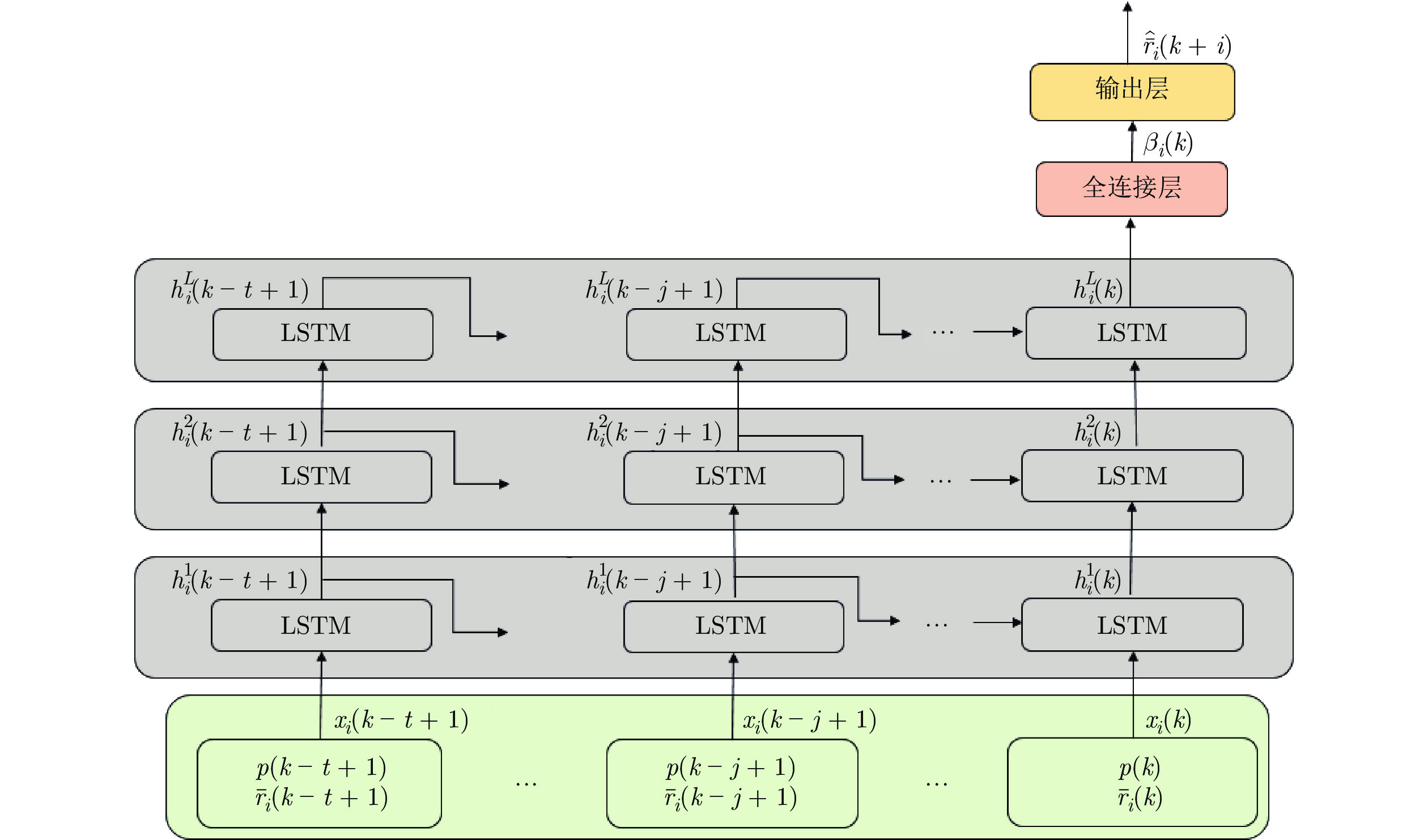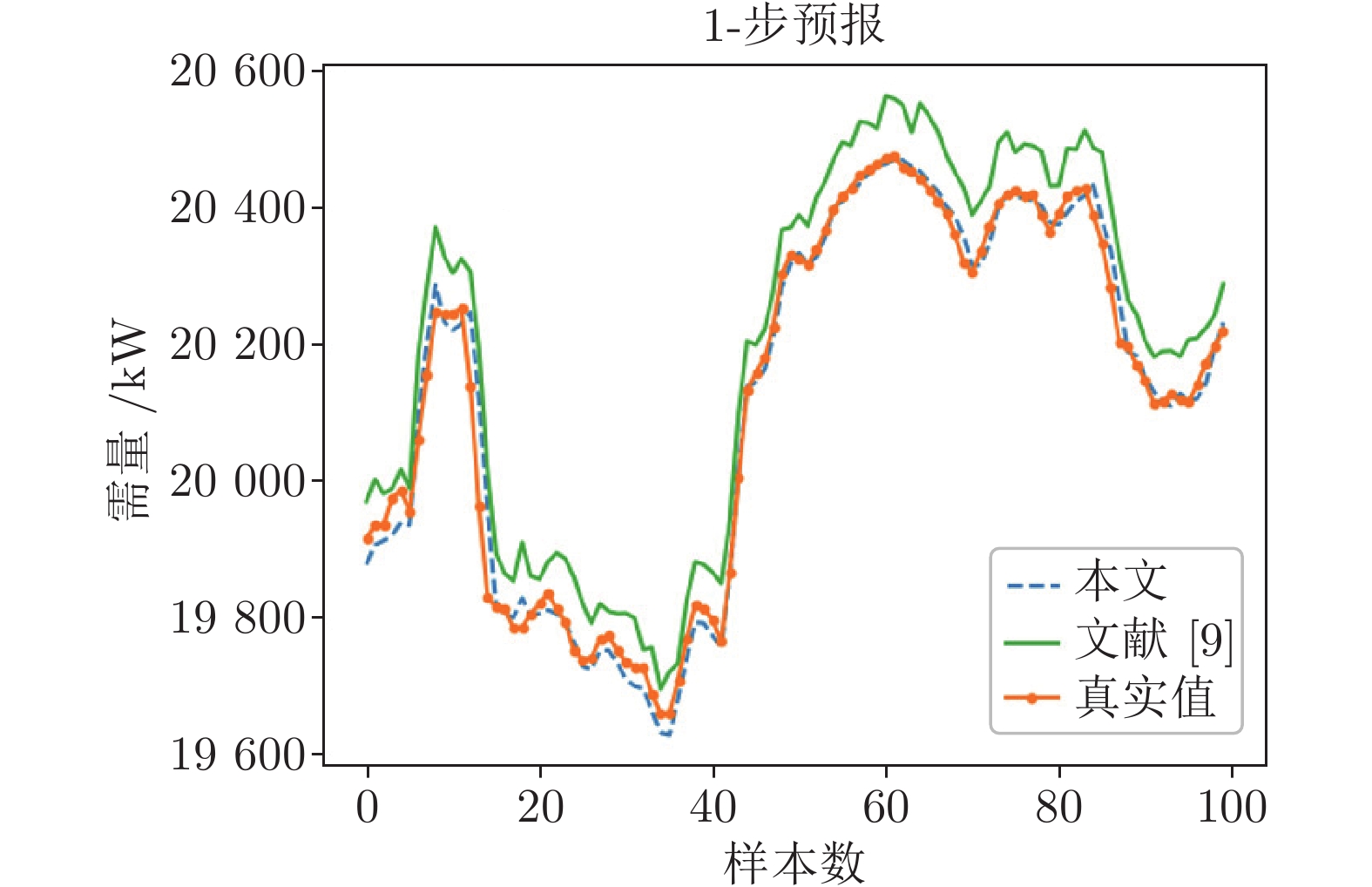Multi-step Intelligent Forecasting Method for Electricity Demand of Fused Magnesia Production
-
摘要: 电熔镁砂生产 (Fused magnesia smelting process, FMSP)用电需量会出现先升后降的尖峰现象, 当峰值达到用电需量限幅值, 会将电熔镁炉(Fused magnesia furnace, FMF)拉闸断电. 为避免尖峰时刻的不必要拉闸需要对需量尖峰进行识别, 因此需要进行需量多步预报. 利用电熔镁砂生产过程熔化电流闭环控制系统方程建立了由线性模型和未知非线性动态系统组成的需量多步预报模型, 将系统辨识与深度学习相结合提出了端边云协同的电熔镁砂生产用电需量多步智能预报方法. 采用电熔镁砂生产过程的工业大数据的实验结果验证了所提的预报方法可以准确预报需量的变化趋势.Abstract: The electricity demand in a fused magnesia smelting process (FMSP) may first rise and then fall gradually, a phenomenon called demand peak. The fused magnesia furnace (FMF) will be switched off when the demand peak value reaches the limit. In order to avoid unnecessary FMF switching-off at the demand peak, it is necessary to identify the demand peak and predict next multi-step demand. In this paper, we develop a multi-step ahead demand forecasting model of the electricity demand based on the closed-loop control system of the smelting current in the FMSP. The multi-step ahead demand forecasting model combines an identifiable linear model with an unknown nonlinear dynamic system. A multi-step intelligent forecast method for electricity demand in the FMSP is proposed based on the system identification and deep learning with the edge-cloud coordination. The experimental results using real data of the FMSP in a fused magnesia factory verify that the proposed method can effectively predict the trend of demand.
-
表 1 $ { TP}_i(k), { FP}_i(k), { TN}_i(k), {FN}_i(k)$的计算方式
Table 1 Formula mode of ${ TP}_i(k), { FP}_i(k), $ ${ TN}_i(k), {FN}_i(k) $
$\hat{\bar{r} }_i(k)-\hat{\bar{r} }_i(k-1)\geq 0$ $\hat{\bar{r} }_i(k)-\hat{\bar{r} }_i(k-1) < 0$ $\bar{r}_i(k)-\bar{r}_i(k-1)\geq 0$ ${TP}_i(k)=1$ ${FP}_i(k)=1$ $\bar{r}_i(k)-\bar{r}_i(k-1)< 0$ ${FN}_i(k)=1$ ${TN}_i(k)=1$ 表 2 需量预报精度对比
Table 2 Precision comparison of demand forecast
预报步数$i$ 1 2 3 4 5 6 7 8 9 10 $R^2_i\;(\%)$ 本文 99.96 99.62 99.59 99.47 99.39 99.31 98.99 98.51 98.03 97.95 文献[9] 90.34 90.05 89.77 89.54 88.73 88.48 88.01 87.76 87.33 86.94 ${{RMSE} }_i$ 本文 9.93 11.06 11.99 13.03 13.89 14.73 16.05 16.83 17.93 18.78 文献[9] 24.92 30.01 34.49 39.99 44.79 50.23 54.93 60.05 65.32 70.64 ${{MAPE} }_i\;(\%)$ 本文 0.04 0.05 0.05 0.06 0.06 0.07 0.07 0.08 0.08 0.08 文献[9] 0.11 0.13 0.15 0.18 0.20 0.22 0.24 0.27 0.29 0.32 $TPR_i\;(\%)$ 本文 94.88 93.21 92.19 91.42 90.17 89.77 88.21 90.05 91.55 89.66 文献[9] 86.12 82.11 80.05 80.11 78.94 79.33 79.11 77.06 80.15 79.02 $TNR_i\;(\%)$ 本文 93.22 94.67 92.19 92.01 94.21 93.18 90.96 89.99 88.12 90.01 文献[9] 81.12 80.04 80.67 83.72 79.99 80.15 77.56 86.77 80.15 76.91 -
[1] 吴志伟, 柴天佑, 吴永建. 电熔镁砂产品单吨能耗混合预报模型. 自动化学报, 2013, 39(12): 2002-2011WU Zhi-Wei, CHAI Tian-You, WU Yong-Jian. A hybrid prediction model of energy consumption per ton for fused magnesia. Acta Automatica Sinica, 2013, 39(12): 2002-2011 [2] 吴高昌, 刘强, 柴天佑, 秦泗钊. 基于时序图像深度学习的电熔镁炉异常工况诊断. 自动化学报, 2019, 45(8): 1475-1485Wu Gao-Chang, Liu Qiang, Chai Tian-You, Qin S. Joe. Abnormal condition diagnosis through deep learning of image sequences for fused magnesium furnaces. Acta Automatica Sinica, 2019, 45(8): 1475-1485 [3] 王维洲, 吴志伟, 柴天佑. 电熔镁砂熔炼过程带输出补偿的PID控制. 自动化学报, 2018, 44(7): 1282-1292Wang Wei-Zhou, Wu Zhi-Wei, Chai Tian-You. PID control With output compensation for the fused magnesia smelting process. Acta Automatica Sinica, 2018, 44(7): 1282-1292 [4] Zhang J W, Li K, Chai T Y. Demand forecasting of a fused magnesia smelting process based on LSTM and FRA. In: Proceedings of the LSMS 2020 and ICSEE 2020 (LSMS and ICSEE). Shanghai, China: Springer, 2020. 201−215 [5] Jornaz A, Samaranayake V A. A multi-step approach to modeling the 24-hour daily profiles of electricity load using daily splines. Energies, 2019, 12(21): 41-69 [6] An N, Zhao W G, Wang J Z. Using multi-output feedforward neural network with empirical mode decomposition based signal filtering for electricity demand forecasting. Energy, 2013, 49(1): 279-288 [7] Bonetto R, Rossi M. Parallel multi-step ahead power demand forecasting through NAR neural networks. In: Proceedings of the IEEE International Conference on Smart Grid Communications (IEEE Smart Grid Comm). Sydney, Australia: IEEE, 2016. 314−319 [8] Li R., Chen X L., Balezentis T, Dalia S, Niu Z Y. Multi-step least squares support vector machine modeling approach for forecasting short-term electricity demand with application. Neural Computing and Applications, 2021, 33(3): 301-320 [9] Li G, Li Y, Roozitalab F. Midterm load forecasting: a multi-step approach based on phase space reconstruction and support vector machine. IEEE Systems Journal, 2020, 14(4): 4967-4977 doi: 10.1109/JSYST.2019.2962971 [10] Yang Y, Shang Z H, Chen Y, Chen Y H. Multi-objective particle swarm optimization algorithm for multi-step electric load forecasting. Energies, 2020, 13(3): 532-541 doi: 10.3390/en13030532 [11] Liu J M, Chen R, Liu L M, Harris J L. A semi-parametric time series approach in modeling hourly electricity loads. Journal of Forecasting, 2006, 25(8): 537-559 doi: 10.1002/for.1006 [12] Srinivasan D. Energy demand prediction using GMDH networks. Neurocomputing, 2008, 72(3): 625-629 [13] Cai Y, Wang J Z, Tang Y, Yang Y C. An efficient approach for electric load forecasting using distributed ART (adaptive resonance theory) and HS-ARTMAP (Hyper-spherical ARTMAP network) neural network. Energy, 2011, 36(2): 1340-1350 doi: 10.1016/j.energy.2010.11.005 [14] 何峰, 钟婷, 谭貌. 基于二次EEMD的工业电能需量多步预测. 计算技术与自动化, 2021, 40(3): 72-77He Feng, Zhong Ting, Tan Mao. Multi-step forecasting of industrial electrical power demand based on twice ensemble empirical mode decomposition. Computing Technology and Automation, 2011, 40(3): 72-77 [15] 赵征, 周孜钰, 南宏钢. 基于VMD的CNN-BiLSTM超短期风电功率多步区间预测. 华北电力大学学报: 自然科学版, 2022, 49(4): 91-97Zhang Zheng, Zhou Zi-Yu, Nan Hong-Gang. Research on multi-step interval forecasting of CNN-BiLSTM ultra-short-term wind power based on VMD. Journal of North China Electric Power University: Natural Science Edition, 2012, 49(4): 91-97 [16] 杨杰, 柴天佑, 张亚军, 吴志伟. 数据与模型驱动的电熔镁群炉需量预报方法. 自动化学报, 2018, 44(8): 1460-1474Yang Jie, Chai Tiang-You, Zhang Ya-Jun, Wu Zhi-Wei. Data and model driven demand forecasting method for fused magnesium furnace group. Acta Automatica Sinica, 2018, 44(8): 1460-1474 [17] Yang J, Chai T Y, Luo C, Wen Y. Intelligent demand forecasting of smelting process using data-driven and mechanism model. IEEE Transactions on Industrial Electronics, 2019, 66(1): 9745-9755 [18] Chai T Y, Zhang J W, Yang T. Demand forecasting of the fused magnesia smelting process with system identification and deep learning. IEEE Transactions on Industrial Informatics, 2021, 17(2): 8387-8396 [19] Qin P, Nishii R, Nakagawa T. ARX models for time-varying systems estimated by recursive penalized weighted least squares method. Journal of Math for Industry, 2010, 2(10): 109-114 [20] Hochreiter S, Schmidhuber J. Long short-term memory. Neural Computation, 1997, 10(9): 1735-1780 [21] Kiran R, Soumitri S, Mitra K. Deep learning based dynamic behavior modelling and prediction of particulate matter in air. Chemical Engineering Journal, 2021, 426(3): 13-22 [22] Greff K, Srivastava R K, J Koutn k, et al. LSTM: A search space odyssey. IEEE Transactions on Neural Networks and Learning Systems, 2016, 28(10): 2222-2232 [23] Wang W J, Li Y M. Analysis of the mean absolute error (MAE) and the root mean square error (RMSE) in assessing rounding model. In: Proceedings of the 5th International Conference on Mechanical Engineering, Materials Science and Civil Engineering. Kuala Lumpur, Malaysia: IEEE, 2018. 324 [24] Cheung G W, Rensvold R B. Evaluating goodness-of-fit indexes for testing measurement invariance. Structural Equation Modeling A Multidisciplinary Journal, 2002, 9(2): 233-255 doi: 10.1207/S15328007SEM0902_5 -





 下载:
下载:






